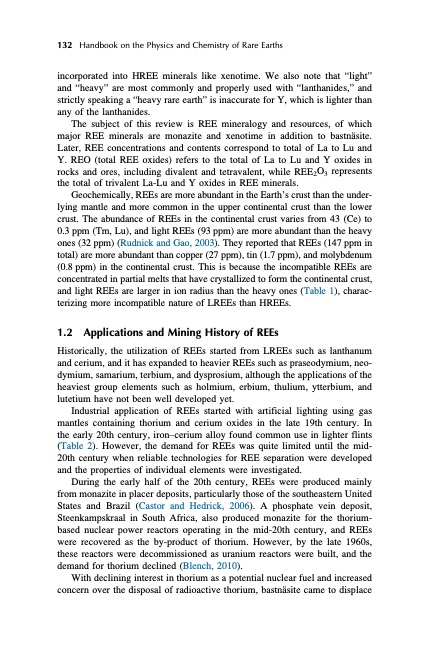
PDF Publication Title:
Text from PDF Page: 168
132 Handbook on the Physics and Chemistry of Rare Earths incorporated into HREE minerals like xenotime. We also note that “light” and “heavy” are most commonly and properly used with “lanthanides,” and strictly speaking a “heavy rare earth” is inaccurate for Y, which is lighter than any of the lanthanides. The subject of this review is REE mineralogy and resources, of which major REE minerals are monazite and xenotime in addition to bastnäsite. Later, REE concentrations and contents correspond to total of La to Lu and Y. REO (total REE oxides) refers to the total of La to Lu and Y oxides in rocks and ores, including divalent and tetravalent, while REE2O3 represents the total of trivalent La-Lu and Y oxides in REE minerals. Geochemically, REEs are more abundant in the Earth’s crust than the under- lying mantle and more common in the upper continental crust than the lower crust. The abundance of REEs in the continental crust varies from 43 (Ce) to 0.3 ppm (Tm, Lu), and light REEs (93 ppm) are more abundant than the heavy ones (32 ppm) (Rudnick and Gao, 2003). They reported that REEs (147 ppm in total) are more abundant than copper (27 ppm), tin (1.7 ppm), and molybdenum (0.8 ppm) in the continental crust. This is because the incompatible REEs are concentrated in partial melts that have crystallized to form the continental crust, and light REEs are larger in ion radius than the heavy ones (Table 1), charac- terizing more incompatible nature of LREEs than HREEs. 1.2 Applications and Mining History of REEs Historically, the utilization of REEs started from LREEs such as lanthanum and cerium, and it has expanded to heavier REEs such as praseodymium, neo- dymium, samarium, terbium, and dysprosium, although the applications of the heaviest group elements such as holmium, erbium, thulium, ytterbium, and lutetium have not been well developed yet. Industrial application of REEs started with artificial lighting using gas mantles containing thorium and cerium oxides in the late 19th century. In the early 20th century, iron–cerium alloy found common use in lighter flints (Table 2). However, the demand for REEs was quite limited until the mid- 20th century when reliable technologies for REE separation were developed and the properties of individual elements were investigated. During the early half of the 20th century, REEs were produced mainly from monazite in placer deposits, particularly those of the southeastern United States and Brazil (Castor and Hedrick, 2006). A phosphate vein deposit, Steenkampskraal in South Africa, also produced monazite for the thorium- based nuclear power reactors operating in the mid-20th century, and REEs were recovered as the by-product of thorium. However, by the late 1960s, these reactors were decommissioned as uranium reactors were built, and the demand for thorium declined (Blench, 2010). With declining interest in thorium as a potential nuclear fuel and increased concern over the disposal of radioactive thorium, bastnäsite came to displacePDF Image | HANDBOOK ON THE PHYSICS AND CHEMISTRY OF RARE EARTHS

PDF Search Title:
HANDBOOK ON THE PHYSICS AND CHEMISTRY OF RARE EARTHSOriginal File Name Searched:
Chemistry-Rare-Earths-49.pdfDIY PDF Search: Google It | Yahoo | Bing
Sulfur Deposition on Carbon Nanofibers using Supercritical CO2 Sulfur Deposition on Carbon Nanofibers using Supercritical CO2. Gamma sulfur also known as mother of pearl sulfur and nacreous sulfur... More Info
CO2 Organic Rankine Cycle Experimenter Platform The supercritical CO2 phase change system is both a heat pump and organic rankine cycle which can be used for those purposes and as a supercritical extractor for advanced subcritical and supercritical extraction technology. Uses include producing nanoparticles, precious metal CO2 extraction, lithium battery recycling, and other applications... More Info
| CONTACT TEL: 608-238-6001 Email: greg@infinityturbine.com | RSS | AMP |